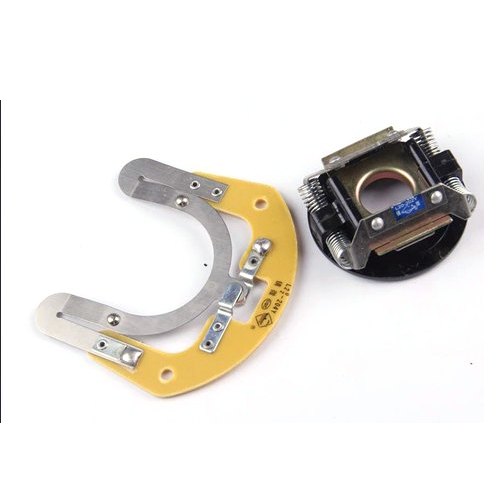1. The current in the R-L circuit at a time t = 0+ is?
a) V/R
b) R/V
c) V
d) R
Ans:- a) V/R
2. The expression of current in R- C circuit is?
a) i=(V/R)exp(t/RC )
b) i=(V/R)exp(-t/RC )
c) i=(V/R)-exp(t/RC )
d) i=(V/R)-exp(-t/RC )
Ans:- b) i=(V/R)exp(-t/RC )
3. The time constant of an R-C circuit is?
a) RC
b) R/C
c) R
d) C
Ans: a) RC
4. After how many time constants, the transient part reaches more than 99
percent of its final value?
a) 2
b) 3
c) 4
d) 5
Ans:- d) 5
5. In an R-C circuit, when the switch is closed, the response
____________
a) do not vary with time
b) decays with time
c) rises with time
d) first increases and then decreases
Ans:- b) decays with time
6. The time constant of an R-L circuit is?
a) RL
b) R/L
c) L/R
d) L
Ans: c) L/R
7. A CR network is one which consists of _________
a) A capacitor and resistor connected in parallel
b) A capacitor and resistor connected in series
c) A network consisting of a capacitor only
d) A network consisting of a resistor only
Ans:- b) A capacitor and resistor connected in series
8. At DC, capacitor acts as _________
a) Open circuit
b) Short circuit
c) Resistor
d) Inductor
Ans:- a) Open circuit
9. At DC, inductor acts as _________
a) Open circuit
b) Short circuit
c) Resistor
d) Inductor
Ans:- b) Short circuit
10. The expression of current in R- L circuit is?
a) i=(V/R)(1+exp((R/L)t))
b) i=-(V/R)(1-exp((R/L)t))
c) i=-(V/R)(1+exp((R/L)t))
d) i=(V/R)(1-exp((R/L)t))
Ans:- d) i=(V/R)(1-exp((R/L)t))
11. The steady state part in the expression of current in the R-L circuit is?
a) (V/R)(exp((R/L)t))
b) (V/R)(-exp((R/L)t))
c) V/R
d) R/V
Ans:- c) V/R
12. In the expression of current in the R-L circuit the transient part is?
a) R/V
b) (V/R)(-exp((R/L)t))
c) (V/R)(exp((R/L)t))
d) V/R
Ans:- b) (V/R)(-exp((R/L)t))
13. For an R-L-C circuit, we get [D – (K1 + K2)][D – (K1 – K2)] i = 0. If
K2 is positive, then the curve will be?
a) damped
b) over damped
c) under damped
d) critically damped
Ans:- b) over damped
14. If the roots of an equation are real and unequal, then the response will
be?
a) critically damped
b) under damped
c) over damped
d) damped
Ans:- c) over damped
15. If the roots of an equation are complex conjugate, then the response
will be?
a) over damped
b) critically damped
c) damped
d) under damped
Ans:- d) under damped
16. If the roots of an equation are real and equal, then the response will be?
a) over damped
b) damped
c) critically damped
d) under damped
Ans:- c) critically damped
17. In the sinusoidal response of R-L circuit, the complementary function
of the solution of i is?
a) ic = ce-t(R/L)
b) ic = cet(RL)
c) ic = ce-t(RL)
d) ic = cet(R/L)
Ans:- a) ic = ce-t(R/L)
18. The particular current obtained from the solution of i in the sinusoidal
response of R-L circuit is?
a) ip = V/√(R2+(ωL)2) cos(ωt+θ+tan-1(ωL/R))
b) ip = V/√(R2+(ωL)2) cos(ωt+θ-tan-1(ωL/R))
c) ip = V/√(R2+(ωL)2) cos(ωt-θ+tan-1(ωL/R))
d) ip = V/√(R2+(ωL)2) cos(ωt-θ+tan-1(ωL/R))
Ans:- b) ip = V/√(R2+(ωL)2) cos(ωt+θ-tan-1(ωL/R))
19. The value of ‘c’ in complementary function of ‘i’ is?
a) c = -V/√(R2+(ωL)2) cos(θ+tan-1(ωL/R))
b) c = -V/√(R2+(ωL)2) cos(θ-tan-1(ωL/R))
c) c = V/√(R2+(ωL)2) cos(θ+tan-1(ωL/R))
d) c = V/√(R2+(ωL)2) cos(θ-tan-1(ωL/R))
Ans:- b) c = -V/√(R2+(ωL)2) cos(θ-tan-1(ωL/R))







0 Comments